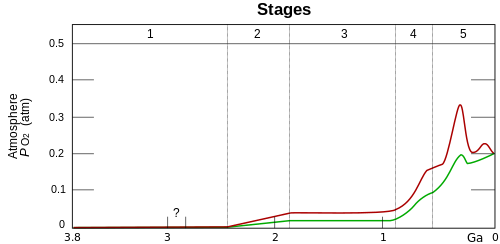
Back Peristiwa pengoksigenan Neoproterozoik Malay Den neoproterozoiske oksygeneringshendelsen NB 新元古代氧化事件 Chinese

- Stage 1 (3.85–2.45 Ga): Practically no O2 in the atmosphere. The oceans were also largely anoxic – with the possible exception of O2 in the shallow oceans.
- Stage 2 (2.45–1.85 Ga): O2 produced, rising to values of 0.02 and 0.04 atm, but absorbed in oceans and seabed rock. (Great Oxidation Event)
- Stage 3 (1.85–0.85 Ga): O2 starts to gas out of the oceans, but is absorbed by land surfaces. No significant change in oxygen level.
- Stages 4 and 5 (0.85 Ga – present): Other O2 reservoirs filled; gas accumulates in atmosphere.[1] Stage 4 is known as the neoproterozoic oxygenation event.
The Neoproterozoic Oxygenation Event (NOE), also called the Second Great Oxidation Event, was a geologic time interval between around 850 and 540 million years ago during the Neoproterozoic era, which saw a very significant increase in oxygen levels in Earth's atmosphere and oceans.[2] Taking place after the end to the Boring Billion, an euxinic period of extremely low atmospheric oxygen spanning from the Statherian period of the Paleoproterozoic era to the Tonian period of the Neoproterozoic era, the NOE was the second major increase in atmospheric and oceanic oxygen concentration on Earth, though it was not as prominent as the Great Oxidation Event (GOE) of the Neoarchean-Paleoproterozoic boundary. Unlike the GOE, it is unclear whether the NOE was a synchronous, global event or a series of asynchronous, regional oxygenation intervals with unrelated causes.[3]
- ^ Holland, Heinrich D. (19 May 2006). "The oxygenation of the atmosphere and oceans". Philosophical Transactions of the Royal Society: Biological Sciences. 361 (1470): 903–915. doi:10.1098/rstb.2006.1838. PMC 1578726. PMID 16754606.
- ^ Och, Lawrence M.; Shields-Zhou, Graham A. (January 2012). "The Neoproterozoic oxygenation event: Environmental perturbations and biogeochemical cycling". Earth-Science Reviews. 110 (1–4): 26–57. Bibcode:2012ESRv..110...26O. doi:10.1016/j.earscirev.2011.09.004. Retrieved 10 November 2022.
- ^ Stern, Robert J.; Mukherjee, Sumit K.; Miller, Nathan R.; Ali, Kamal; Johnson, Peter R. (December 2013). "~750 Ma banded iron formation from the Arabian-Nubian Shield—Implications for understanding neoproterozoic tectonics, volcanism, and climate change". Precambrian Research. 239: 79–94. Bibcode:2013PreR..239...79S. doi:10.1016/j.precamres.2013.07.015. Retrieved 20 December 2022.
© MMXXIII Rich X Search. We shall prevail. All rights reserved. Rich X Search